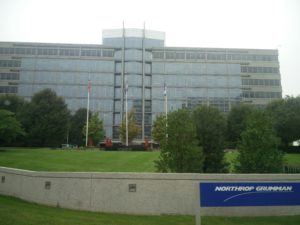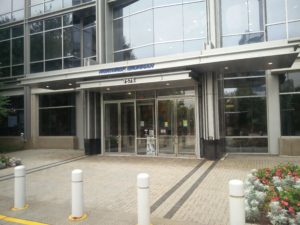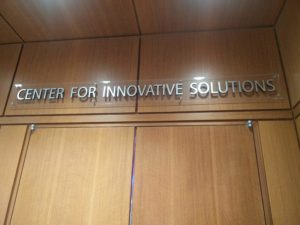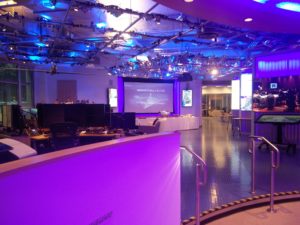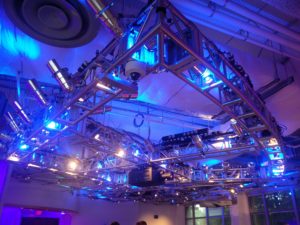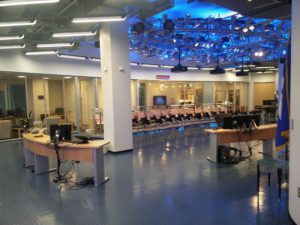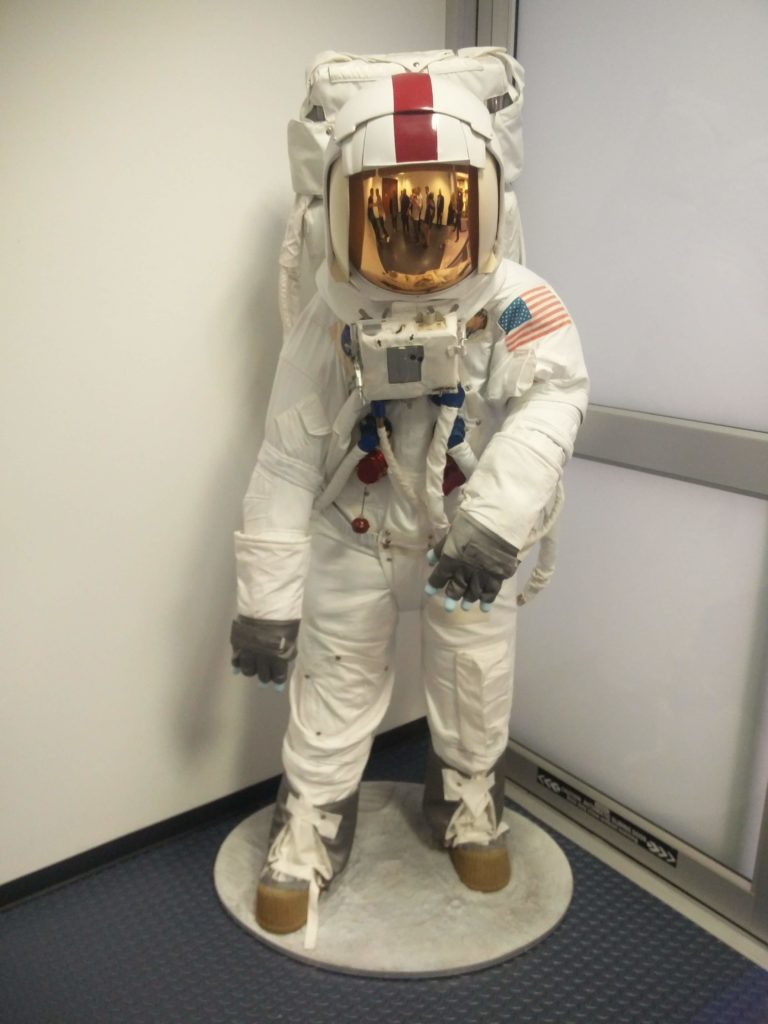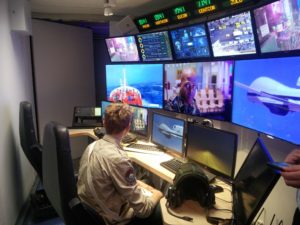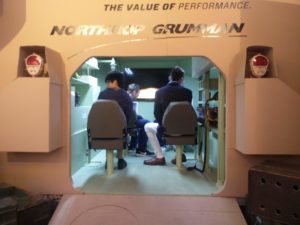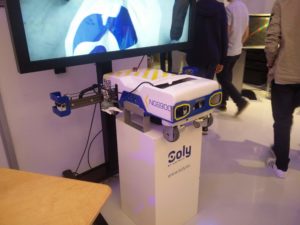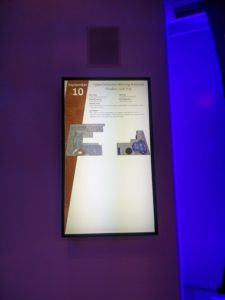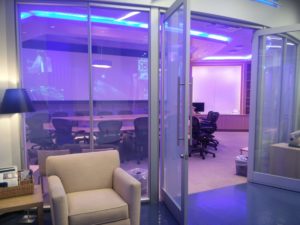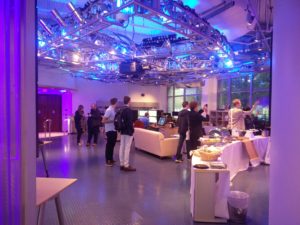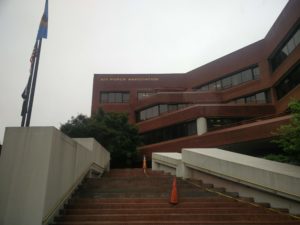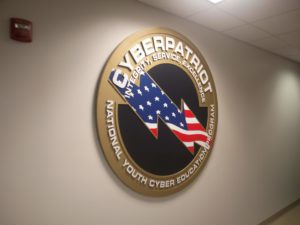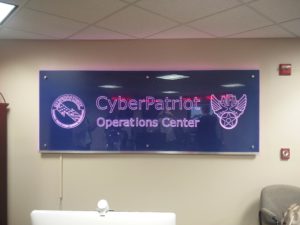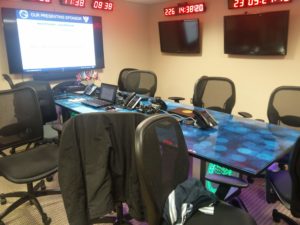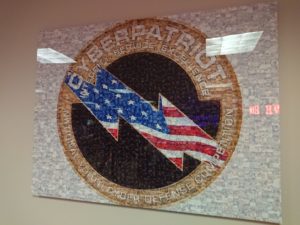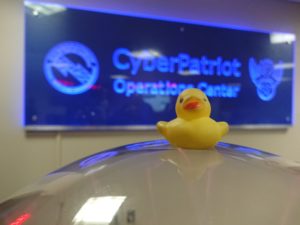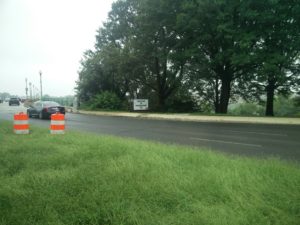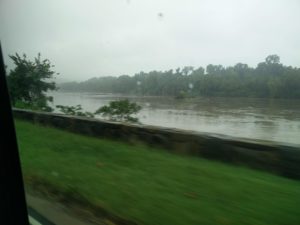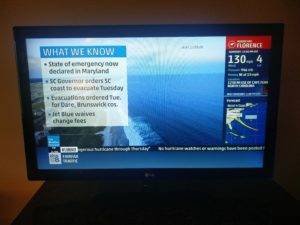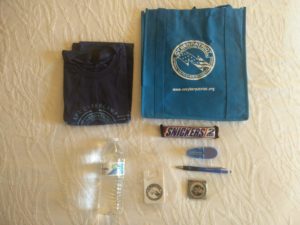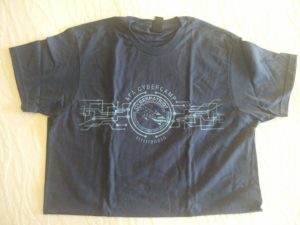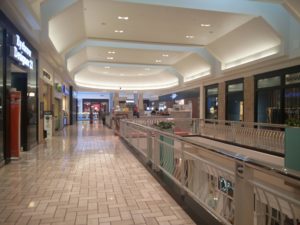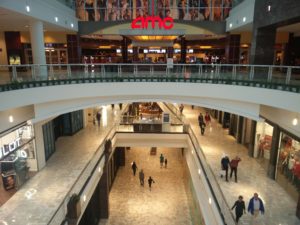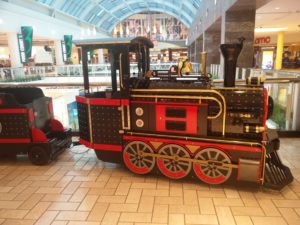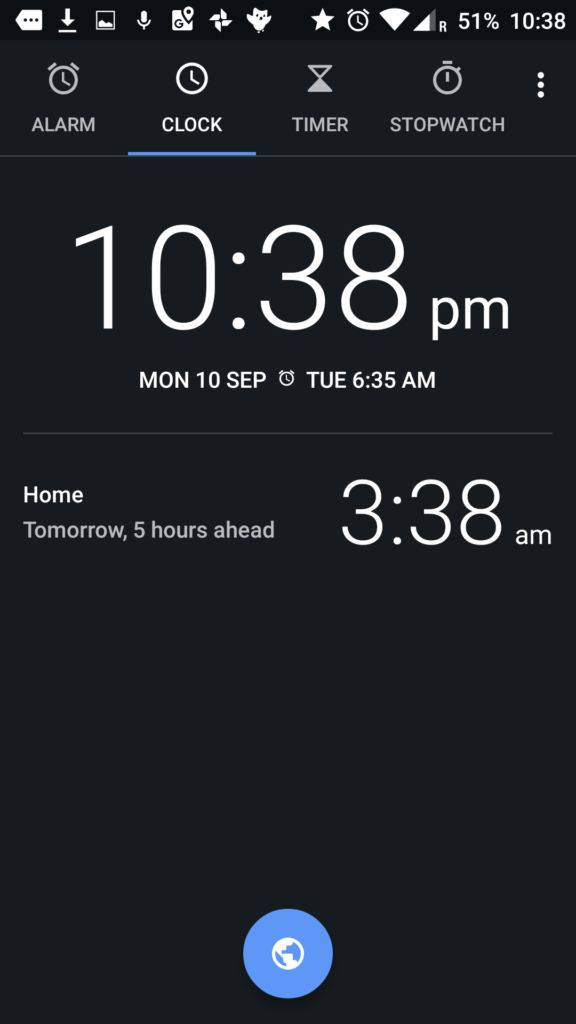Elmo is on the news! The hurricane that is coming is still the most reported thing in the news. Seriously, I have no idea what on earth has gone on in the rest of the world, just that there’s a number of hurricanes coming to American countries. Anyway, Elmo was on to help explain to children about what a hurricane is and what parents are going to do. Honestly, it’s a great idea. Besides, it’s better than the alternative of looking at adverts about drugs, drugs, insurance, and drugs that are not approved by medical professionals so may have a side effect of causing a brain aneurysm and killing you.
We’d decided to have breakfast at 8 am, as we were being picked up from the hotel at 9:30. I was incredibly happy as there were Froot Loops available, which is what I had hoped for (it’s well know this is the greatest cereal ever created). Also available were fruit and some cooked items. A student decided to have a waffle, which a few of us also decided to have. After pouring the batter out of a container and into a cup, he followed the instructions on the waffle iron and poured it in and closed the lid. Unfortunately, while he filled it to the full line printed on the cup, it oozed out of the sides. The instructions said that it’d beep when it was cooked, but after waiting a good few minutes nothing happened. It was then that he realised that the instructions said to turn it upside down to start the timer! He did, but due to the batter already oozing out, it was then stuck on the outside going upwards. After about a minute, the beeper went off and he removed his successfully. The next student knew what to do this time, but upon trying to remove it, it got stuck to the waffle iron. After quite a bit of prodding, he was then able to remove it!
Everyone finished their breakfast and the bill was brought over. It was around $12 for each breakfast, coming to a total amount of $109.00, which we rounded up to $120 with a tip. We decided to collect anything we needed from our rooms and meet up at 9am. About quarter past all of the students turned up, and we got onto the minibus (the same model as yesterday). The Northrop Grumman building with the Innovation Center we were going to was about a 10 minute drive. We were let through the security barrier and went into the building. Diane Miller was there to greet us, along with one member of staff who was on a personal development program. We waited in the lobby for a bit of time, as over the evening there had been a power problem and things were being turned on again. We made small talk and introduced ourselves and about 10 minutes later went into the room.
And what a room! There was a lighting grid emitting white and blue light, a number of desks around the room with triple, quad and hex screen layouts. Additionally there were a large number of screens advertising products the company is working on, and various other projectors displaying similar information. We were told that when there are important meetings with high level defence people, they come here, along with winners of the CyberPatriot program. We were taken into another part of the room, which was a large-ish with chairs set out for us and a triple projector setup.
We had a presentation from a staff member who informed us how cyber security and healthcare were quite interlinked. Not in the way that you think with protecting patient data, but also using the same techniques to look at outliers with what patients have been through. He went through a number of examples, using charts to show how computers had processed a large amount of data to find things that shouldn’t be there. One of these was where funding for healthcare has been spent over time using a bubble chart animating the spending over various months. It showed that asthma spending had remained relatively stable, but for other conditions it had increased significantly. Another chart was spending versus how it is helping patients. While pre-cancer funding had helped (e.g. to raise awareness, initial treatment to avoid it spreading) to reduce the amount of patients, a majority of the funding was going to operations and post-operative care.
He also explained how it could help identify fraud. One chart was 3D, which mapped how much patients had spent for the same medical treatment. Around 10,000 patients each paid about $52 whereas 10 patients paid approximately $28,000 each for the same treatment. Additionally he also explained how computers were able to process large amounts of data (each persons individual genome data takes about 1TB up in storage capacity) to group it to identify outliers. One of these is looking at the spending of the same operation across numerous patients, including their recovery times and addition operations. He showed how this could be drilled down to find a 4 year old who had about $440,000 spent on them for a knee operation. This patient had also undergone multiple additional operations. He explained while this could be an outlier, it may also possibly be the operations that were needed as best practice. The way to work out this is to use humans to ask questions. He then took a few questions and then finished his presentation. While it may sound an unusual subject, it certainly was very interesting and informative.
Next up was the person who looked after the Innovation Center. He explained that any member of staff from Northrop Grumman is free to come along to try out an idea for a project that may not normally fit within the employees normal work. A number of products that are now in use where designed as prototypes in there. Firstly he handed a few of us some tablets and asked us to look around. Everything was normal, but he then held up some images of a boat and an electrical power generator, and using augmented reality they “popped” off the cardboard and became 3D. Moving the tablet around allowed you to have a look around the object in full. He explained this was how the Pokémon Go app worked, and the computing teacher commented how it would help with lessons. Students could go up to a wall display and be able to look around a object in 3D, while being able to view additional information about it.
We then got up from the chairs and moved over to a glass-walled office. There was writing all on the glass of various calculations and graphs, and he shut the door. He explained that the person in the office was working on making an infrared camera that can see through glass, as this isn’t yet possible. He showed this by promptly opening the door and everyone who was in the sight of the camera was immediately visible on the screen in clear quality. To prove it wasn’t a trick, he stood behind the glass window and stuck his hand and arm into the doorway. Only his arm was visible, with the rest of his body blocked by the glass. The person who was waking on this project turned up and did a few other demos, such as holding a cold item to his skin for a few seconds and showing how sensitive the camera was to the changes of heat. They explained that this technology could be used to help find people when trapped in buildings when fully developed.
We carried on around the room, were he showed us a screen. A student put on some 3D glasses that tracked head movement and as he looked around the screen (moving his head like owls do) the image tracked where he was looking and moved as expected. He used a stylus to drop a robot hand onto a button which opened up a screen where you could dissect a robot hand and arm. This was explained it is used by CAD people to look around objects. A button was then pressed that exploded the arm into its various components, which could be looked around and moved. Another demo on this machine was a biological one, where a heart was put on the screen. The heart could be moved and flipped around as needed, with various sections turned off to show how it worked. The stylus also vibrated in time to the heartbeat. This was used for medical professionals, as the whole human body could be looked and and training for medical operations could take place.
The next item was a large screen which could be used for identifying any data leaks. This program would be installed on a customer’s email infrastructure and it would show a number of statistics. Down one side of the screen were the most popular words used, and pressing on a user account would show who they had sent email to in a visual manner. A student asked if it was used at Northrop Grumman at the moment, but they couldn’t confirm nor deny that. Another student asked about the ethics of it, to which the answer was if you’re on a corporate network, you have no privacy. I commented that I’d love to have this tool in work. During this time, a photographer turned up and started taking photos of us (we’d been pre-warned before going on the trip that we’d be treated as rockstars!).
We walked back into the first room that we went in, and they explained why there were blue lights around. It has been scientifically found that that colour light helps stimulate your brain and increase awareness. Additionally, that colour blue is used in TV studios as it smooths out your skin. It is used heavily on live news, as since we swapped over to HD wrinkles were visible in the presenters. A mixture of blue and white light prevents this from happening. Additional research has concluded that being in blue light for long periods of time does not affect your eyes, but as he wore glasses, he was quick to point out that he had these before joining 7+ years ago.
We then left that room and went to one on the other side of the lobby. In the entrance was a replica of a spacesuit warn by Tom Hanks in the film Apollo 13. They did have the original at one point, but the studio asked for it back so they had that in exchange. There were frosted sliding doors that we had to walk through, and we came into an area with a number of exhibits. The person who was giving the tour said that we were free to look, touch and go into most exhibits as he looks after them so would have to fix them if needed anyway. He showed us a device that was used for top secret missions, which one function was to provide satellite connection from a plane to avoid a stationary target on the ground, and the other functions he did not know of, but if had a clear bottom with numerous bits of technology in. A student asked me if he was able to take photos in this room, as there were signs on the entrance door saying to ask permission before taking photos, so I said for him to ask the person giving the tour. The response was if you like your device then not the item we’d just looked at, but everything else was fine.
The next thing we looked at was a portable technical operations center. This was a trailer loaded up with screens and computers, that could be deployed when needed. One is currently in Saudi Arabia providing a base of operations to repair weapons instead of sending them back to the manufacturers. It could also be used in areas where there had been a bio-hazard so that it could provide analysis facilities. Once it was no longer needed at that location, it could then be moved off to another area. It was powered by solar panels, and to get it into the Innovation Center they had to remove a side wall of the building and a number of trees (which have since been replanted, for any environmental people out there). The next exhibit we looked at was a replica of an armoured tank that would double as a mobile analysis center and could take a number of fully kitted out soldiers. It was also used when transporting high ranking military personnel across battlefields, as it was a lot more armoured than a hummer (this one wasn’t – as it was a replica it was made out of wood). We saw a robot that followed tags on a floor to take items to various areas of a factory, such as a delivery company. Next, we were taken into a room full of various technical equipment and numerous bits and pieces, which was a workshop where employees could go to, if they wanted to build a prototype of something they wanted to work on.
We were then taken into another auditorium where a demo was given of a device that emitted a sonic wave from a plate, which then hit another plate above it. When a polystyrene ball was put between the plates, it was held in place, levitating! (This video I like describes it well and does a few demonstrations, although there are a number of other videos too. There’s even a patent from Northrop Grumman, which I think is for the same thing…). We were told this device was invented to clean mirrors from microscopes and satellites that need to be very clean and smooth. When the top plate was removed, the polystyrene ball was repelled, and the person giving the tour said that he doesn’t know why the inventor doesn’t call it what it is, a force-field generator. He shows this by dropping a polystyrene ball onto the pad, and it was flung away before it could even get close to it. We were informed that this technology at the right frequency could destroy missiles without needing to send something to intercept it. A video demo also showed how it is attempting to be used underwater to clear up sunken ships. One of our students asked what would happen if you put your hand in between the plates. The guy leading the talk jokingly said that he thought there were some plasters spare so to give it a go. The student did put their hand in there and (unfortunately) nothing happened. We all had the opportunity to do so as well, and nothing could be felt. When touching the plate, however, it felt “oil like” from how quickly it vibrated. The final exhibit that we saw was a 360 video screen room, the Virtual Immersive Portable Environment, which is used by military personnel to train. For obvious reasons we weren’t able to be shown this training experience, but instead we saw information about the James Webb telescope and how it could unfold. You could tell the person running this center really liked his job, as he put a lot of effort in and was very enjoyable to listen to.
We left this room, after having a few photographs taken, and went back into the first room across the lobby. A buffet lunch had been laid out for us all, with wraps, tortillas, salad, rice, pulled pork, pizza, dips, cakes, cookies and drinks available. During this lunch break, a number of staff who were on the Personal Development Program turned up to tell us of their work and how the program works. This was an informational lunch break, as we all got to hear about the variety of jobs that these staff members had worked on and how this helped them decide what areas they wanted to work at in Northrop Grumman. They also had the opportunity to ask us questions about how the students got into computing and where they would possibly like to do in their future careers.
After this, we had some more of the food that was left and then departed the building around 13:40. We asked if we could take photos of the Innovation Center before we left and we were told we could (there was a big sign on the entrance door saying we couldn’t, hence the asking), but upon leaving the room the students attempted to take photos of the lobby of the building, they were then told they were not allowed to do. We got back into the minibus to be taken the the Air Force Association building (not owned by the Air Force, they help support it instead), which is the place where they build the images and run the competition.
We went into the building and were escorted to the room where everything takes place. There was a large table (which had colour changing LEDs underneath it) in the room where we sat down and were told that it was the main nerve center when the competition is happening, as all calls come in to there. We were also shown a number of other things we could easily see, such as a number of clocks showing different times and a large screen with a world map showing the timezones and where the sun currently is. Frank took the presentation, who the is person who says 5-0 minutes remaining. He played a video that had been taken recently for the Today program (note: at 1 minute and 12 seconds in, the screen in the background is the tool that monitors a customer’s email infrastructure for data leaks, which I mentioned that we saw in the Innovation Center. Actually, watching the video back, I’m sure that those interview scenes may have been filmed in the Innovation Center…), talked about how the CyberPatriot and CyberCenturion programmes are the same and different (American schools have to pay) and mentioned that other Cyber competitions are being launched in other countries this year too. Additionally, there are different programs for various age groups, from KS3 to senior citizens, to bring awareness to cyber security. We all had the chance to “win” a book that was being given away for whoever guessed the correct number between 1 & 20. I was going to pick 16 (as that is hexadecimal) but changed my number to 8. Everyone said a different number, and the answer was 16! Well, I obviously decided to change it to give the students a better chance of winning. (The student who guessed 15 won). I also noticed that we were on slide number 16, so I don’t know if this was also a giveaway too? Last time I decide to change my mind…
We were then taken around to meet some of the other members of staff. We met Lisa who helps check the images and comes up with most of the issues, and also met some of the other members of staff who design the logos and help run the competition. We were also handed handed some CyberPatriot t-shirts and a tote bag containing a water bottle, Snickers bar, light up pen, bulldog clip, card holder and medal with a Cesar cipher wheel at the back of it and a code printed around the outside (I still need to see what it says, but it is far more fancier than the version we get in the UK). The person who generates the images asked us what we thought of them as they now had a chance to get some feedback, and we said that we found them very enjoyable and fun. I did ask cheekily if we could have any tips on what would be coming up on this year’s competition, but was politely told no. I did notice a whiteboard up with some paper covering it stuck on top, so I’m assuming that some notes are written there. After collecting our goody bags, we headed back to the large table (which had colour changing LEDs underneath it – it was so cool I felt the need to mention it again) and asked a few questions. There was then time for some photos of the room, the students to show they had been there, and we took part in the tradition of touching the plasma ball in the room (if you touch it with one hand, you pass knowledge of the challenge to it, and with two hands you remove knowledge). Some of the students used both hands, but those who won’t be doing it again, along with myself, touched it with one hand. We managed to go on this trip with their knowledge (and mine during the training rounds), so it’s only fair to give some back to other people. There was also a lava lamp in the room, and above it a mosaic of the CyberPatriot logo made of small images of CyberPatriot finalists. The student who took his rubber duck down to the finals has also taken it on this trip, so he took some photos with it too.
This concluded our time at the CyberPatriot headquarters, so we headed out from the building. At this point, it had become very hot and humid, and everyone commented about this. There was slight drizzle, but that helped to cool things down a bit. However, the air conditioning on the minibus was very welcome indeed.
The minibus took us back to the Northrop Grumman building to drop Diane off, going near Washington DC, alongside the Potomac River (it’s very wide!) and passing the CIA entrance on part of the route (I saw the sign advertising it but didn’t get a chance to take a photo of it), then we headed back to the hotel. It was around 4pm at this time, so we decided that we’d go out for food that evening as there was a local mall nearby.
Oh, I’ve just realised why all of the news is about weather. What I thought was a news channel (which is what my TV defaults to then I turn it on, and what I’ve seen on the screens at Northrop Grumman) is actually the Weather Channel! Why on earth is it designed identical to how news channels look?! (I’m writing this part up to now up in my room while also looking through my goody bag). Also, pro tip (from the recently identified Weather Channel): don’t tape up your windows when a hurricane is going to happen, but put a board over the window instead. Why, you ask? Well, the reason is that tape doesn’t protect the window from breaking, and if it does break, the tape holds the glass together in larger pieces so it’s more dangerous. Don’t say that I never give out helpful advice!
We congregated in the hotel lobby around 6 and figured out exactly where we wanted to go. There was an outlet store a few miles away, but looking at how much it’d cost for 2 taxis there and back it came to nearly $100. That was too much to pay, so we instead went with the hotel shuttle bus (free within a 2 mile radius) to go to the local mall. During this time we were talking about the hurricane, and that it’s now being reported on the BBC news channels too. I commented about thinking I was watching the news channel, and one of the students who is sharing a room said that they also hadn’t realised their room mate had changed it over and wondered why they were talking so much about it too. See, it’s not just me!
The journey was fairly quick to the mall at Tysons Corner, and we had a short walk to a food court area. During this walk I was asked by a stall holder if I’d like to try out some hair straighteners (I think) but couldn’t really respond as the group was moving on. We decided that we’d meet up in an hour, at 7:30. I walked around with another member of staff, and we commented on how big the mall is. We found a larger food court area at the top of the mall on the third floor, and as we are walking past the food stalls we were talked to by the staff and offered tasters. We politely declined, but commented to ourselves how much different it is than the UK, as people actually talk to you here. Additionally on this floor was a kids play area and, most importantly, a land train (which you had to pay to go on, unfortunately). We made a note of where the food court was and carried on through the mall. We got to what we thought was the end of the mall, but found that it went around a corner and there was still a large length remaining. After walking around some of the stores (we went into the largest Lush in the whole of North America), every one we went into we were greeted by staff. Again, it was nice and being polite, but certainly different to what we’re used to.
Everyone met up around the designated time and we headed up to the food court. There were a few different stalls, but as one of the students is vegetarian and the payment would have to be done on one card, we headed into TGI Friday’s instead. The waiting staff seemed slightly confused about our split table request (us staff had looked after the students all day, it was our time off now), but they agreed. The staff were friendly and came over to let us know it was happy hour so alcoholic drinks were cheaper. We ordered some drinks, but as it’s America you need to be ID’d. I had taken my passport with me to the various places we’d been to today, but took it out before we went to the mall. A manager had to come over to verify that I was over 21, and although I had a photo of my passport on my phone, they needed to ask me the questions “are you over 21?” and “when is your date of birth?”. That was it! What a rubbish system to verify that you’re able to drink! Anyways the food came after a small delay due to there being so many of us, but it was nice.
When we finished, the total food bill was around $140, which was only slightly more expensive than the breakfast! We paid for our drinks separately, and they’d helpfully printed some prices of tips at various levels. I had to have my card swiped and sign a receipt, as chip and pin doesn’t really exist in the United States yet (a technologically advanced country, right?). After this, we called the shuttle to take us back. This could have gone smoother, as we didn’t know the name of the place where we were and we weren’t prepared for them to ask any questions, so we settled on a variation of “we’re the large group of British people and we’d like to be picked up where the guy dropped us off please“.
Back at the hotel, which was a short and quick journey, we agreed to meet up at 7:45 as we needed to leave earlier to get to the places we’d be visiting tomorrow. We were also told we’d need to have our passports with us to gain access to the building. I’m back in my room now, and they’re still going on about hurricane Florence. It seems like it’s going to be a big one, as it’s going to hit areas that haven’t been hit since the 1950’s.
Right that’s it, off to bed. It’s going to be another busy day tomorrow… (and it’s 3:30 in the morning at home!)
